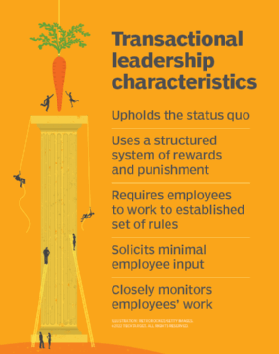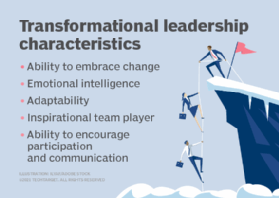transactional leadership
What is transactional leadership?
Transactional leadership, also known as managerial leadership, is a leadership style where leaders rely on rewards and punishments to achieve optimal job performance from their subordinates.
The transactional executive leadership model is based on an exchange or transaction. The leader rewards workers who perform their tasks to the specified levels and punishes workers who do not perform to those set standards.
This relationship between leader and subordinates is based on theories that assume individuals are not self-motivated and need structure, instruction and supervision to accomplish their jobs. The theory also postulates that workers will perform their tasks as the transactional leader wants them to do in exchange for the leader's offering something the workers want, such as pay.
The three approaches to transactional leadership are the following:
- Contingency. Transactional leadership uses reinforcement theory and extrinsic motivation based on a system of rewards, incentives and punishment. Employees earn contingent rewards and perks if they reach their goal.
- Active management by exception. Transactional leaders rely on active monitoring by default to anticipate issues and take corrective action in response to problems.
- Passive management by exception. Transactional leaders stay out of the team's way by default and only intervene when employee performance expectations aren't met.
These methods are used in combination with each other to achieve transactional leadership.
Transactional leadership characteristics
Transactional leadership assumes that there are superiors and subordinates, and that subordinates demonstrate the following characteristics:
- not self-motivated;
- motivated by reward and punishment;
- follow clearly defined goals; and
- must be closely monitored and managed.
A transactional style of leadership works best in a structured environment where there are few deviations from established business processes and defined roles with specific tasks to accomplish.
According to transactional leadership theory, this type of leader works within an organization's existing structure. A transactional leader seeks to have subordinates deliver specific results that are articulated and measurable. These are sometimes referred to as SMART goals , which stands for specific, measurable, achievable, realistic and time-bound.
A transactional leader evaluates subordinates on whether they meet defined requirements and expected results. Transactional leaders appeal to the self-interest of their subordinates to keep them on track.

Transactional leaders are often:
- direct
- less open to change
- practical
- reactive
Transactional leadership implementations generally:
- aim to follow rules precisely;
- encourage efficiency;
- favor structure over flexibility;
- focus on short-term goals;
- involve less personal connection; and
- use rewards and reprimands.
Brief history of transactional leadership
Some of the significant figures behind the development of leadership theory were the following:
- Max Weber. In his 1947 publication The Theory of Social and Economic Organization, this German sociologist established the idea of different leadership styles and described what would eventually become known as transactional leadership theory.
- James MacGregor Burns. As a political scientist, historian and presidential biographer, Burns was also a pioneer in the field of leadership studies. He advanced transactional leadership theory in his 1978 book titled Leadership, in which he laid out the elements of transactional leadership and described how the transformational leadership style relied on charismatic leadership and inspiration. Burns contrasted the two leadership approaches, claiming they were mutually exclusive types of leadership.
- Bernard M. Bass. As a distinguished professor at the State University of New York at Binghamton, Bass furthered the understanding of transactional leadership in his work in the 1980s. He added to Burns' and Weber's work, specifying ways in which transformational leadership could be measured and how leadership styles impact motivation and performance. Bass also suggested that although transformational and transactional styles differed, they were not mutually exclusive.
The transactional leadership style was prevalent in the U.S. after World War II. Many modern businesses, with their focus on innovation and change, prefer other supervisory styles, such as transformational leadership. While these are more common in corporate culture today, transactional leaders remain valued in organizations such as the military and large companies where rules and regulations dominate.
Transactional vs. transformational leadership
Transactional leadership is frequently contrasted with transformational leadership. These styles are opposites and often seen as incompatible. Leaders in each model rely on a different set of leadership skills.
Transactional leaders
Transactional leadership is called a telling management style, because the leader tells subordinates what to do. A transactional approach upholds the status quo. Transactional leaders focus on achieving short-term goals and performing tasks correctly and to specifications. They typically don't drive change but follow established protocols and procedures.
A transactional leader does not generally fit well in entrepreneurial environments where creativity and innovation are required. Transactional leadership works best in scenarios where there are set protocols and procedures and a more rigid structure. A transactional leader works well in an organization transitioning to a more procedural or linear style of management, like the waterfall model.

Transformational leaders
Transformational leadership is considered a selling management style. These leaders sell employees on their vision and motivate and inspire workers to challenge the status quo and work toward a larger goal.
Transformational leaders have more personal connection with subordinates. They are often more hands-off and have a charismatic approach that intrinsically motivates employees without rewards and punishments. This type of leadership drives change. These leaders do well in situations where expectations aren't always clear and rigid, and there is more room to test and experiment -- such as in Agile and DevOps implementations.
Servant leaders
Transactional leadership also contrasts with servant leadership. This approach places service to others and the needs of others -- including other employees -- above the needs of the business and the existing work hierarchy and procedures.

Advantages and disadvantages of transactional leadership
The transactional leadership model has a range of benefits and drawbacks.
Advantages
- Efficiency. It can achieve short-term goals quickly.
- Consistency. It can facilitate delivery of consistent results with the use of established procedures and protocols even across large and dispersed organizations.
- Clarity. It provides a clear chain of command and clear expectations concerning each team member's responsibilities. This makes troubleshooting and crisis management easier.
- Stability. It supports work environments that require a high level of repetition. It upholds and emphasizes company rules and regulations and can be well suited to high-pressure situations.
Disadvantages
- Inflexible. Transactional leadership focuses on maintaining the status quo, not on change. As a result, leadership and the business can be rendered inflexible.
- Lack of innovation. Transactional leadership theory has been criticized for its focus on maintaining established procedures at the expense of innovation. It has been faulted for its inability to inspire and foster creativity.
- Demotivating. Employees are not encouraged to take personal initiative, and their input is not always embraced. This can negatively affect employees' motivation to work hard.
- Rigidity. Taking a boilerplate, repetitive approach to tasks can lead to mistakes being repeated or caught late in the process, creating problems and inefficiencies.
- Incrementalism. Transactional leaders focus on achieving incremental, short-term goals; they struggle to identify and achieve broader, long-term goals. This can be a disadvantage when companies face more nimble, visionary rivals.
Examples of transactional leadership
Transactional leadership is best suited to occupations that require a high level of structure or supervision. It is also suitable for emergency settings where careful monitoring and rapid intervention are necessary.
For example, for a company that experiences a data breach, transactional leadership would be ideal for implementing the recovery plan and ensuring that sensitive assets are quickly secured and accounted for.
Another example is in the armed forces, where the safety of the team and the mission rely on everyone following orders to a high degree of precision. Here, a mistake could endanger people's lives.
Many organizations favor the transformational and servant leadership styles that prioritize the employee's input and experience over rigid, repetitive structure. Learn how human resources departments are using journey maps to better understand the employee experience and find out what matters to employees.






